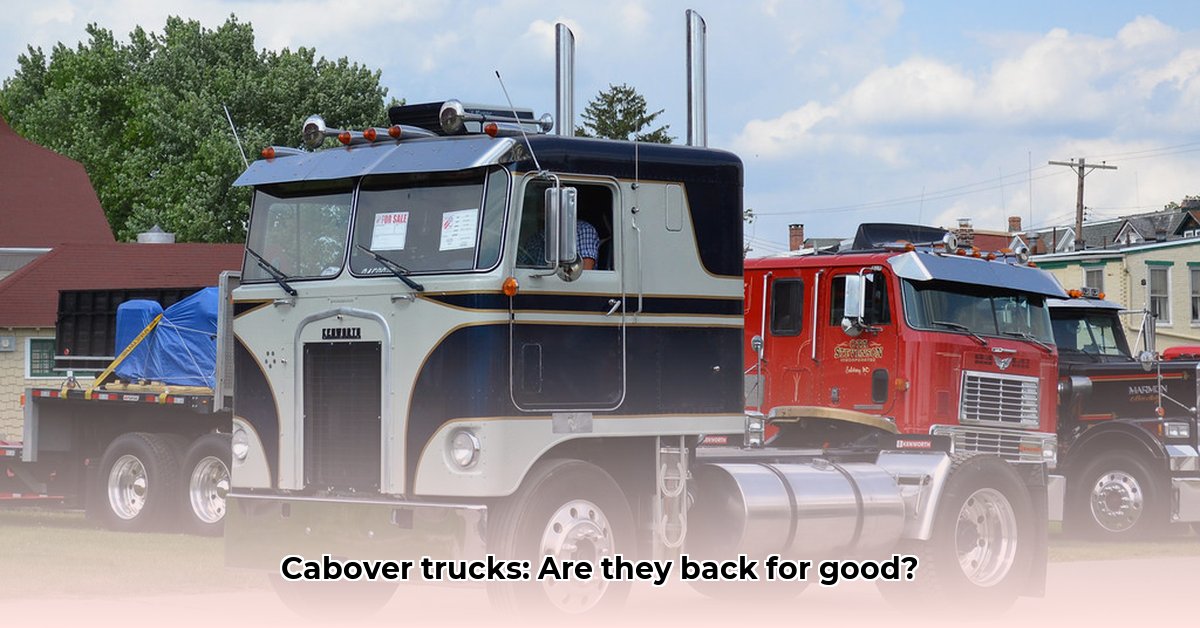
The Rise and Fall (and Possible Rise Again?) of the Cabover
The cabover truck—that iconic design with the engine tucked beneath the cab—wasn't always a niche player. For decades, particularly in North America, it reigned supreme. Its compact design maximized cargo space while adhering to strict length regulations, making it the workhorse of the trucking industry. These were dependable, efficient trucks, built for the job. But the trucking world, like any other industry, is constantly evolving. For more on efficient vehicle design, see this resource.
The 1970s brought significant regulatory shifts, easing length restrictions. This opened the door for the conventional tractor—engine in front of the cab—which offered drivers more space and comfort. Perceived safety advantages further fueled the shift away from cabovers. While the cabover's efficiency was undeniable, its cramped interior paled in comparison to its longer counterpart. Drivers prioritized space, and manufacturers responded accordingly. Did this shift represent a failure of the industry to appreciate the cabover's strengths, or was it simply a matter of evolving driver preferences?
Yet, the cabover never completely disappeared. In regions with tighter length regulations, such as Europe, Japan, and Australia, it remained a mainstay. Its compact form excels in urban environments, offering superior maneuverability in congested areas and unparalleled visibility in city streets. This adaptability ensured its survival in specific niches. But could a resurgence be on the horizon?
Recent interest in cabovers isn't purely nostalgic. While the classic appeal certainly plays a role, practical factors are driving the renewed attention. Specific applications and an increasing focus on fuel efficiency are repositioning the cabover as a viable option for many trucking operations. The question remains: can this renewed interest translate into a significant market share recapture? The answer, at this stage, remains uncertain.
Navigating the Challenges of a Cabover Revival
The potential comeback of the cabover isn't without its hurdles. Meeting modern safety standards poses a significant challenge. Many older cabovers, while visually appealing, lack the advanced safety features now considered standard. Parts availability for older models also presents a significant obstacle. However, modern iterations are addressing these issues directly, integrating cutting-edge safety systems and designs. Will these advancements be enough to overcome the legacy of safety concerns?
The Future of the Cabover: A Niche Renaissance?
Truck manufacturers are reassessing the cabover's place in the industry. Its inherent strengths—maneuverability and fuel efficiency—make it ideal for specific market segments. City deliveries, specialized hauling, and regions with stringent regulations are prime candidates for cabover utilization. While a return to its previous dominance in long-haul trucking seems unlikely, its niche appeal ensures its continued relevance. The cabover's story continues, a testament to adaptation and a potential for a remarkable renaissance.
Pivotal Points:
- The cabover's compact design offers superior fuel efficiency and maneuverability, particularly advantageous in urban settings.
- Regulatory changes in the 1970s shifted market preference towards conventional tractors, leading to a decline in cabover popularity.
- Renewed interest in cabovers is driven by a combination of nostalgic appeal and practical advantages like fuel efficiency and maneuverability in specific applications.
How to Enhance Cabover Truck Safety Standards
The cabover's design, while advantageous for its compact size and maneuverability, has a significant safety drawback: the lack of a substantial crumple zone. This lack of a crumple zone significantly increases the risk of severe leg and lower-body injuries in head-on collisions. These are risks that can't be ignored.
Addressing the Safety Deficit: A Multi-Faceted Approach
Improving cabover safety requires collaborative action from manufacturers, regulators, and drivers alike. This is not merely about setting better standards; it's about a fundamental shift in trucking safety culture.
- Manufacturer Innovation: Manufacturers must invest in research and development to create innovative crumple zone designs specifically for cabovers. This necessitates exploring alternative materials and structural engineering techniques.
- Regulatory Stringency: Government agencies need to strengthen crashworthiness standards, addressing the unique challenges of cabover design. This could involve mandatory safety features, updated testing protocols, and possibly restrictions on cabover use in high-risk situations.
- Driver Education: Comprehensive driver training programs emphasizing defensive driving techniques and the inherent safety risks associated with cabovers are crucial.
- Technological Integration: Implementing advanced driver-assistance systems (ADAS) such as automatic emergency braking and lane departure warnings is essential to mitigate the increased vulnerability of cabovers.
The future of the cabover truck hinges on addressing these safety concerns. A collaborative effort is crucial to ensure a safe and successful comeback for this classic workhorse.